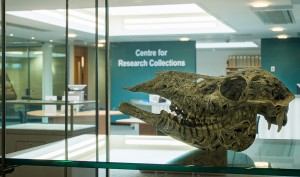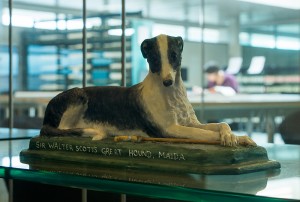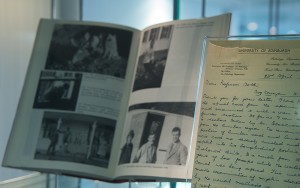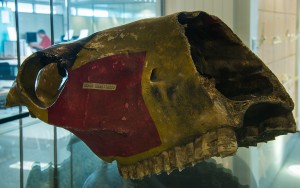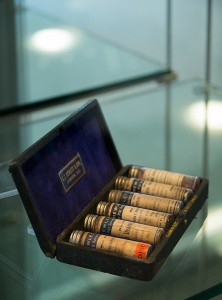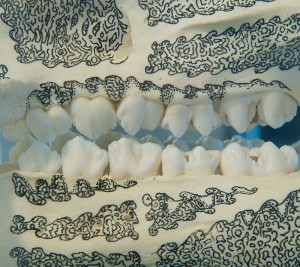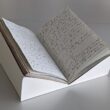Home University of Edinburgh Library Essentials
December 5, 2025
New exhibition on display on the 6th Floor of the Main Library
Posted on July 3, 2013 | in CRC, Exhibitions, Featured | by Blog AdminWelcome to the Centre for Research Collections’ Display Wall where you can discover some of the hidden treasures from the many different collections we are home to. This short-term exhibition highlights the wonderfully interesting items from museum objects to archives to rare books detailing the relationship between humans and animals.
The exhibition will be on until 26th July, so hurry up and come have a look at the Ceramic model of Sir Walter Scott’s favourite deerhound dog Maida and an image of James Cossar Ewart who is well-known for his cross-breeding experiments with horses and zebras. On display are also a series of folklore items, including a milking song, a charm against foxes, and a protection charm for cattle, a few very interesting animal skulls and a folding anatomical model of a dog.
Here is more information about some of the highlights currently on display:
Leighton, Robert. Cassell’s New Book of the Dog. London, n.d. [c.1915?] Vol.1
This handsomely-illustrated set of books on the dog is dedicated to Queen Alexandra, “who has ever been a true friend of dogs”. It includes numerous coloured and photographic plates of different breeds of dog, and a folding anatomical model at the start of volume 1. This copy is part of the historic War Memorial Library of the Veterinary School, which was transferred to Special Collections in 2011.
Ceramic model by Teviotdale Craft & Design Company of Sir Walter Scott’s much-portrayed favourite dog Maida. Maida (1816-1824) was a (male) deerhound presented as a gift to Scott by Alexander Macdonell of Glengarry. Maida is also portrayed on the statue of Scott in the Scott Monument on Princes St. I’m not sure of the exact date but it would be early 20th century.
This case note relates to Kasyan, one of two Samoyed dogs owned by the surgeon and described by Dott as ‘a canine member of my family’. Dott was a life-long lover of animals, and this correspondence and report demonstrate his determination to know that he could not have done more to save his ailing companion, for both his own piece of mind and the ‘veterinary interests’ involved in Kasyan’s treatment. Kasyan is probably pictured in this photograph from Dott’s biography, guarding young Jean Dott.
James Cossar Ewart (1851-1933) was Professor of Natural History at the University of Edinburgh from 1882 to 1927. Ewart is perhaps best known for his cross-breeding experiments with horses and zebras. This research was published as the book The Penycuik Experiments (1899) and was instrumental in finally disproving the long-held theory of telegony (ie that a sire can influence the offspring of subsequent males). Ewart was also influential in the establishment of a Lectureship in Genetics at the University in 1911, and his reputation ensured that Edinburgh was regarded as a key centre for animal breeding and genetics research.
Collections
 Hill and Adamson Collection: an insight into Edinburgh’s past
My name is Phoebe Kirkland, I am an MSc East Asian Studies student, and for...
Hill and Adamson Collection: an insight into Edinburgh’s past
My name is Phoebe Kirkland, I am an MSc East Asian Studies student, and for...
 Cataloguing the private papers of Archibald Hunter Campbell: A Journey Through Correspondence
My name is Pauline Vincent, I am a student in my last year of a...
Cataloguing the private papers of Archibald Hunter Campbell: A Journey Through Correspondence
My name is Pauline Vincent, I am a student in my last year of a...
Projects
 Cataloguing the private papers of Archibald Hunter Campbell: A Journey Through Correspondence
My name is Pauline Vincent, I am a student in my last year of a...
Cataloguing the private papers of Archibald Hunter Campbell: A Journey Through Correspondence
My name is Pauline Vincent, I am a student in my last year of a...
 Archival Provenance Research Project: Lishan’s Experience
Presentation My name is Lishan Zou, I am a fourth year History and Politics student....
Archival Provenance Research Project: Lishan’s Experience
Presentation My name is Lishan Zou, I am a fourth year History and Politics student....

